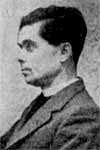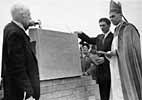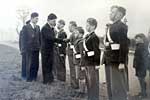For this church:    |
|
 The Rev S Verney The Rev S Verney |
The Rev. Stephen Verney, the first priest-in-charge of the Clifton estate, started in September 1952. A former military intelligence officer during World War Two he was energetic and resourceful and keen to build a church here as soon as possible. Frank Thorne, founder and first captain of the 28th Company (Clifton Detachment) of the Nottingham Battalion Boys' Brigade, suggested that the church could be built by the men and women on the estate who had the necessary skills. Verney enthusiastically adopted the idea and made numerous appearances in the Nottingham newspapers appealing for funding and help with the building project.
The new church was expected to cost £40,000 but Verney travelled round England seeking ideas for reducing the cost. On 4 December 1952 a meeting of Clifton people was held in Wimpey’s canteen on the estate to launch the building of a church by voluntary labour. It was hoped in this way to save £10,000. The architect, Vernon Royle of the Diocesan Surveyor’s office, attended the meeting with his plans and guided the team of workers for the next five years. Originally about fifty men volunteered, but soon a nucleus of about half-a-dozen did the bulk of the work, at evenings and weekends.
 Dr. Russell Barry, Dr. Russell Barry, Bishop of Southwell, blesses the foundation stone, 26 July 1953 |
On 26 July 1953 the foundation stone was laid, appropriately by the local blacksmith, Jack Stevenson, and a bricklayer, Reuben Simpkiss. Dr. Russell Barry, Bishop of Southwell, blessed it.
Meanwhile services were held in the canteen, which was later donated to the church and used as the church hall.
Work progressed slowly, partly due to cash flow problems. But on 19 May 1957 it was finally consecrated by Dr. Barry before a full congregation of about three hundred. Initially great interest was shown in this novel project by the national press and even royalty, as Princess Margaret paid a visit on 9 June 1956. Besides the local newspapers articles had appeared in the Manchester Guardian (27 July 1953) and Daily Mail (10 September 1953) which emphasized the voluntary labour and community spirit shown.
It was christened ‘The People’s Church’.
In October 1958 the Rev. S. Verney left Clifton to become Canon of Coventry Cathedral.
 OS map of the church (1955) OS map of the church (1955)© Crown Copyright and Database Right 2016. Ordnance Survey (Digimap Licence) |
The church consisted of nave and chancel in one church, anteroom and hall, choir, two vestries, organ loft, and a tower with 7 bells.
For the first three decades of its life the church was well supported and well attended. Originally it was recognized as a fairly ‘high’ church. Approximately one hundred people attended the service for its 21st anniversary in April 1978, when Verney, now the Bishop of Repton, returned to preach.
For a time, from 1 November 1976 to 1 December 1985, services were shared with the Methodists, although they did get a hall built at the corner of Rivergreen and Southchurch Drive.
There was a Roman Catholic church in the centre of the estate and the Congregationalists built one near to the central shops.
The United Reform Church and the Pentecostalists have places of worship, but the Baptists and the Salvation Army have now left the estate. In the mid-1990s St. Francis was a member of Churches Together in Clifton.
 Frank Thorne inspects Frank Thorne inspectsmembers of the 28th Company of the Boys Brigade |
For many years the church and the church hall were thriving. The hall was used for shows, pantomimes, Scouts and Girl Guides, bazaars, mothers’ union, youth club, fairs, Saturday night dances (25 in one year) and even a nearly new shop to provide funds for a new boiler. The 28th Company (Clifton Detachment) of the Nottingham Battalion Boys' Brigade, led by Frank Thorne, was also based here and held regular parades along Farnborough Road. Boys Brigade camps were organised in holiday locations like Skegness and Wells next the Sea and Frank's wife, Elsie, founded and led the Lifebuoys, a junior arm of the Boys Brigade.
But by the mid-1990s the hall facilities were being used only twice a week by the Scouts and a Karate class, but with the forthcoming Millennium in mind the Sir Charles Nicholson Group of architects of Grimsby drew up plans in November 1995 for ‘Proposed Extensions and Alterations’ to St. Francis. The project never got beyond the drawing stage. Church attendances had dwindled for some time and the building itself was deteriorating badly. Unless something was done, according to the vicar, the land would be sold and the church demolished.
Again volunteers rallied round to spruce up the building for its 40th anniversary in 1997. After that another funding campaign was launched.
The church building continued to deteriorate, and in October 2009 a DAC report on ‘The Future of the Church’, discussed how St. Francis could continue to be used in spite of serious financial problems.
The 2007 Quinquennial Report had concentrated on the roof problems. The architect Gordon Smith had been given a quote from NRA Roofing & Flooring Services for almost £47,500. Now it was nearer £57,500, a sum which the church had no way of raising. The nave had suffered water ingress in several locations since 2007 and in spring 2009 it had to be closed for worship. The roof of ruberoid felt was cheap but inadequate in the long run. (The Church Commissioners had reluctantly agreed to St. Francis becoming a parish church in 1957 despite the roof construction. They said a permanent roof was essential when ‘the ruberoid needs renewing in c20 years’ time'.)
Since then services have been held in the church hall.
The organ had not been used for some time and the tapestry and kneelers had to be removed.
Meanwhile services continue in the church hall adjacent.
The church hall was also leased to other religious groups. First it was the Charis Life Church, which has now been succeeded by Hope Church, in fellowship with the Assemblies of God, a member of the Evangelical Alliance. In 2013 they held services on Sunday mornings, and a Church of England service follows at 4 p.m.
But the future for the church was bleak. No repairs took place since 2009, and the whole building apart from the hall fell into disrepair. Vandalism and graffiti in the past did not help.
This account has had to be compiled without access to the main church building for health and safety reasons.
St Francis was demolished on 12 July 2019.
In 2013 work began on the extension to Nottingham Tram system immediately outside the churchyard and inside, where a wide track for vehicles has been cut.
Nearby is Clifton Holy Trinity, also in decline but not as badly as St. Francis. One company offered to demolish both churches and build one new church in return for the land on which they stand to be used for social housing.
It is a sad time, particularly for those churchgoers who helped to build the church in the optimistic days of the 1950s.






